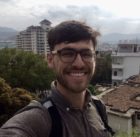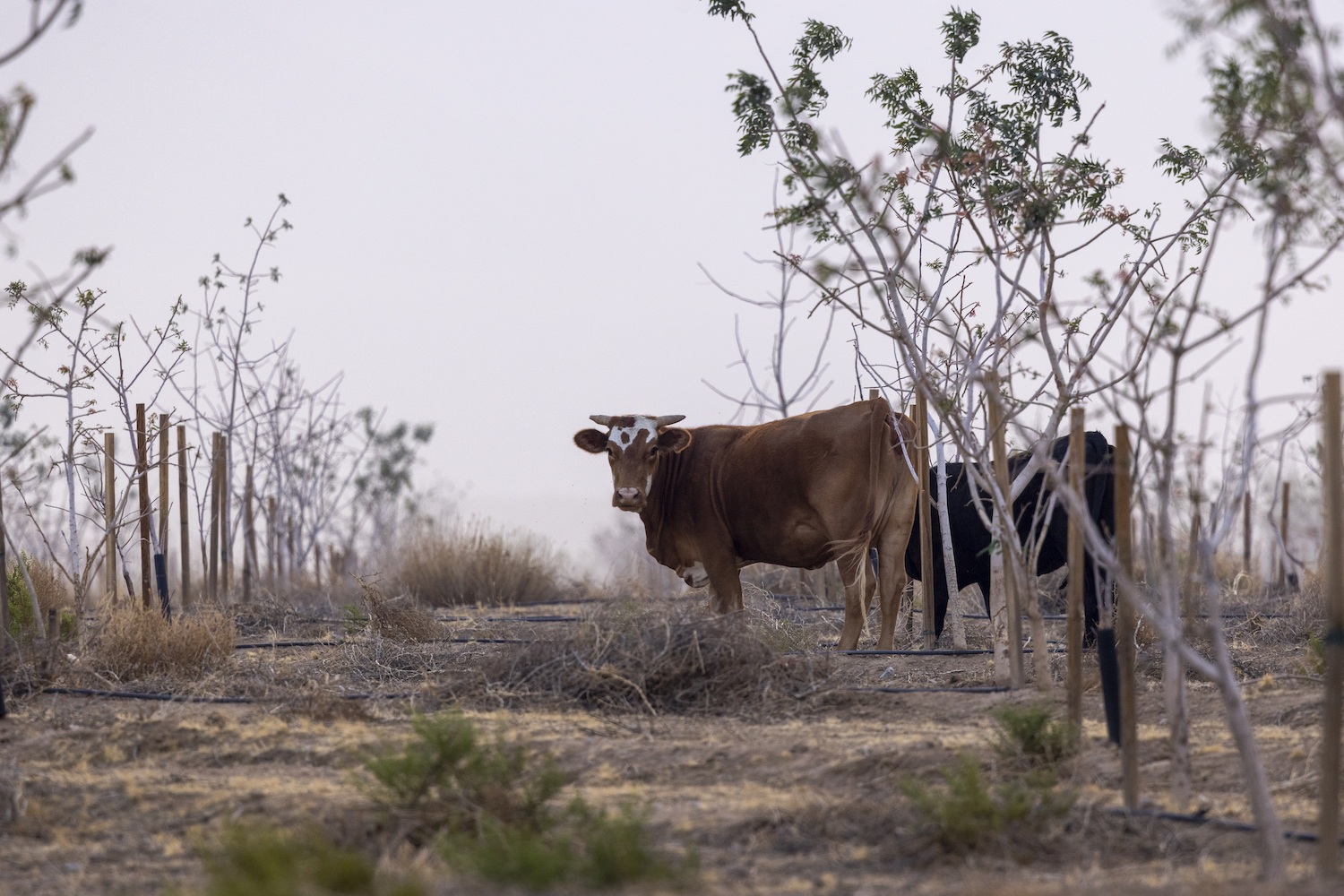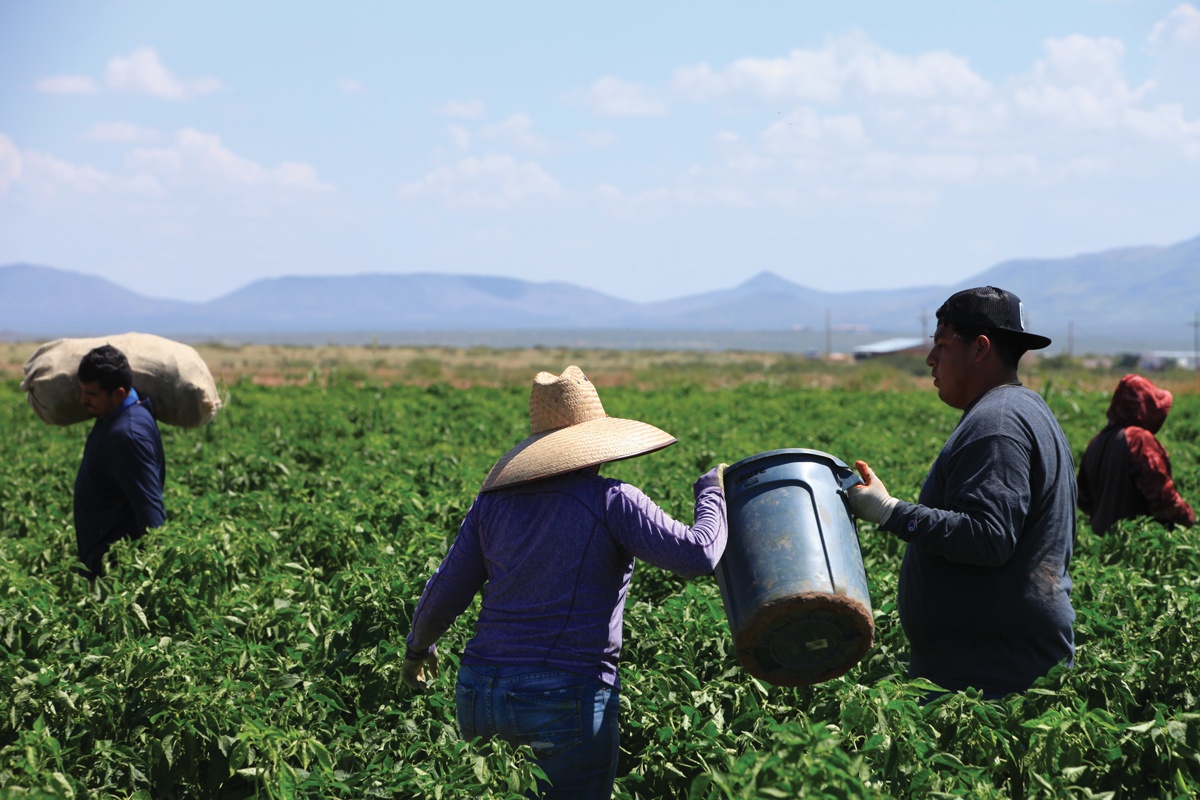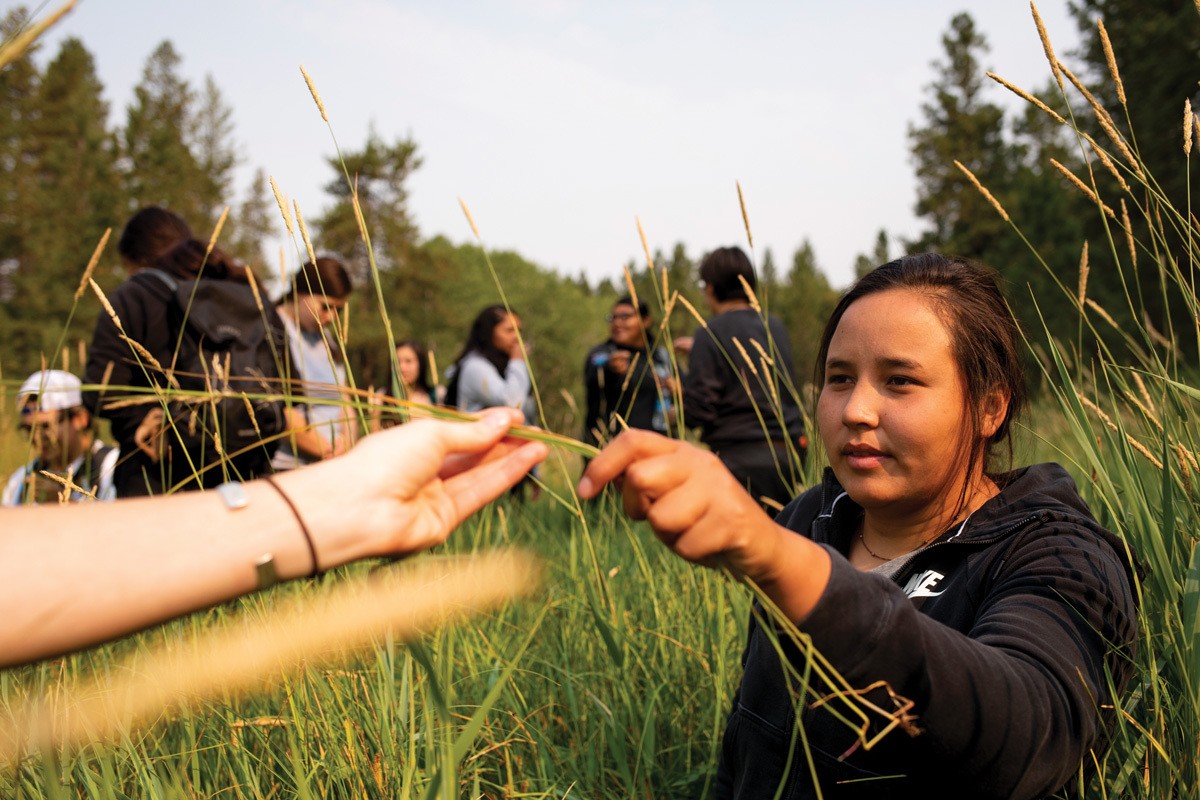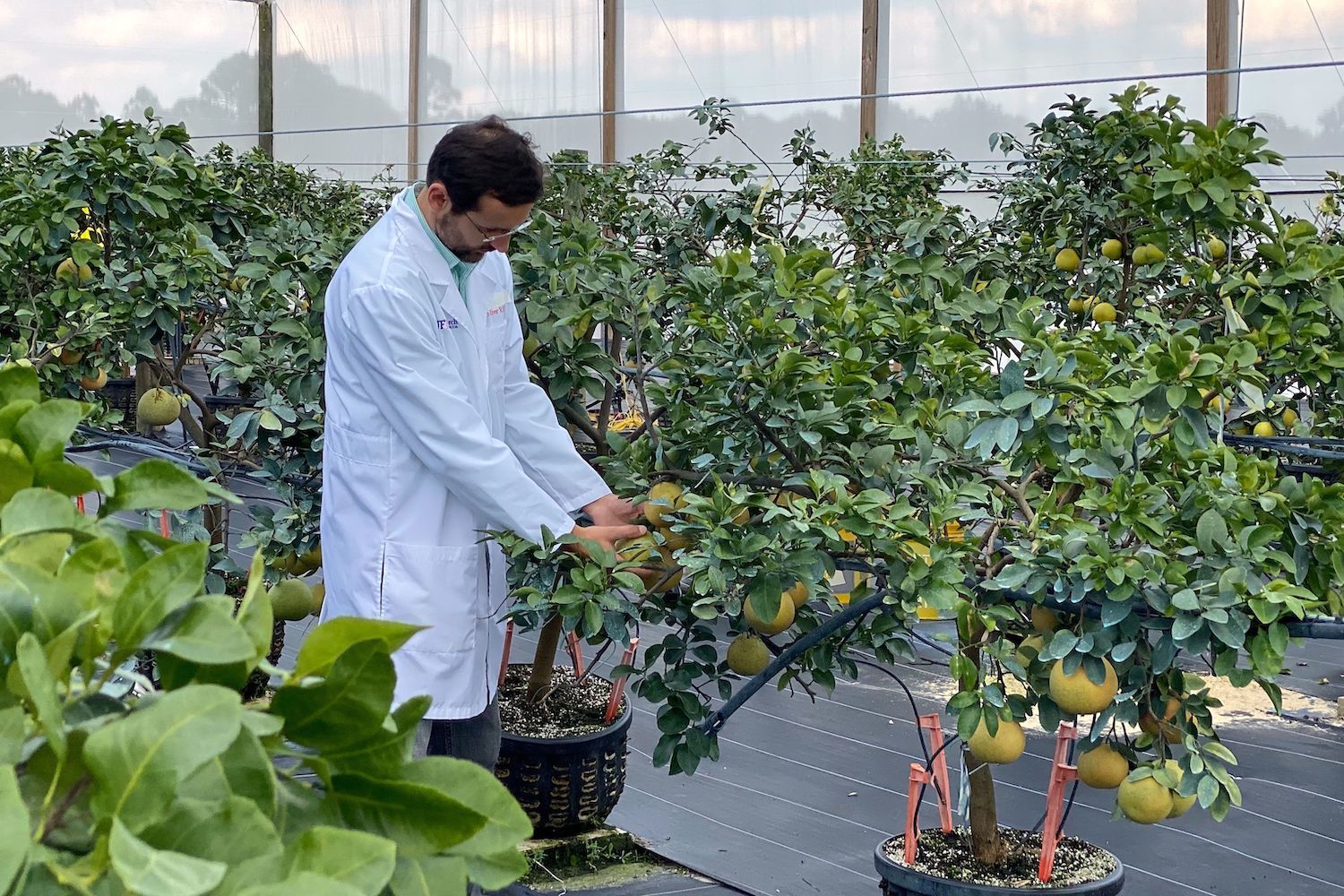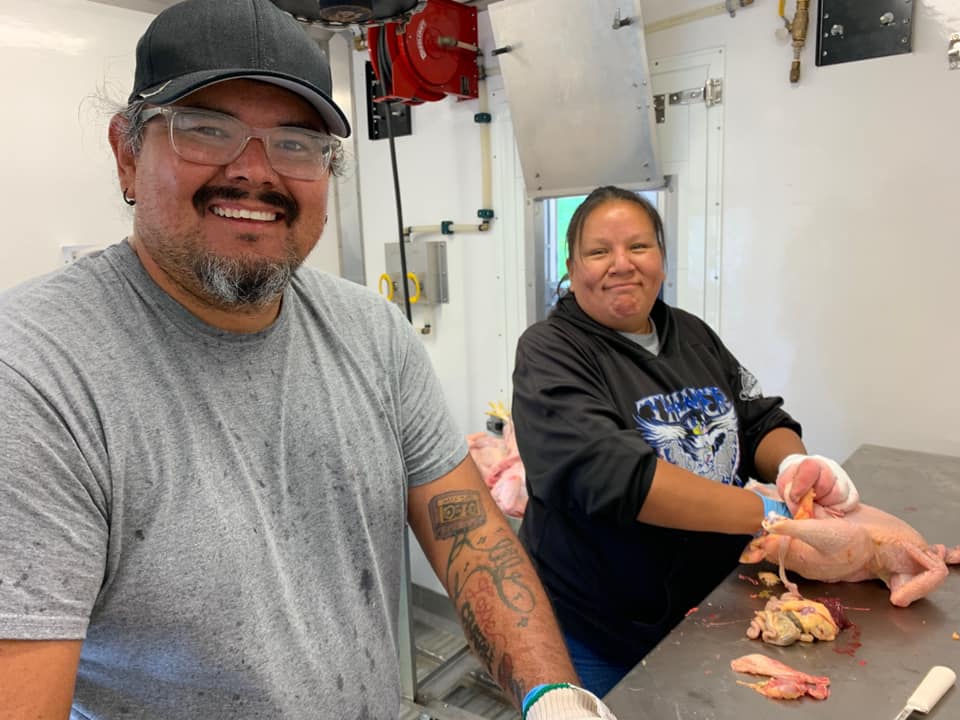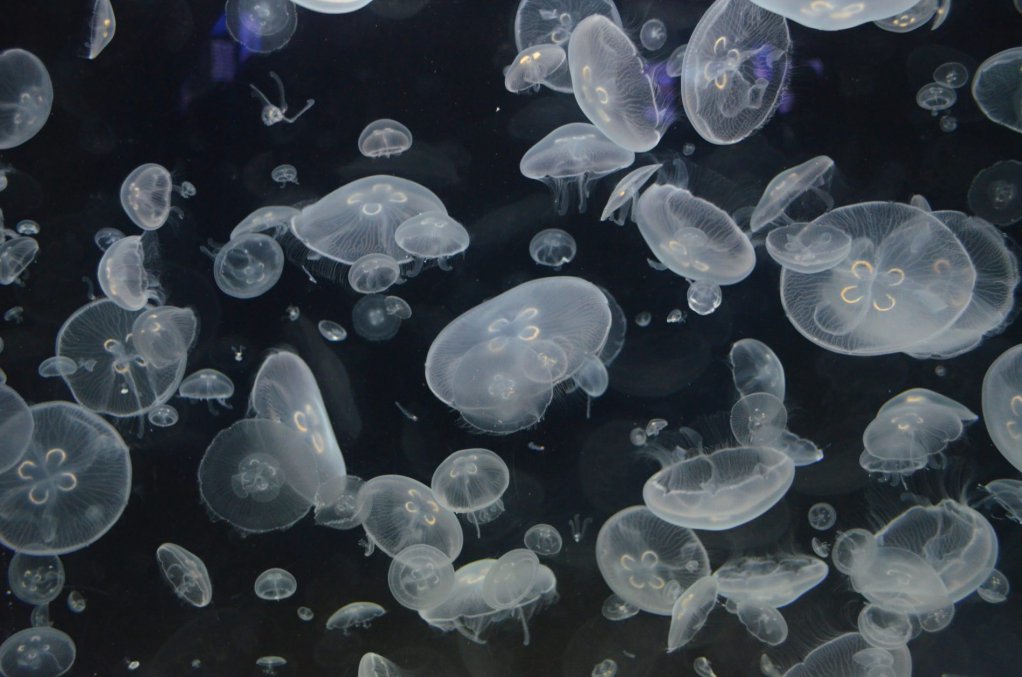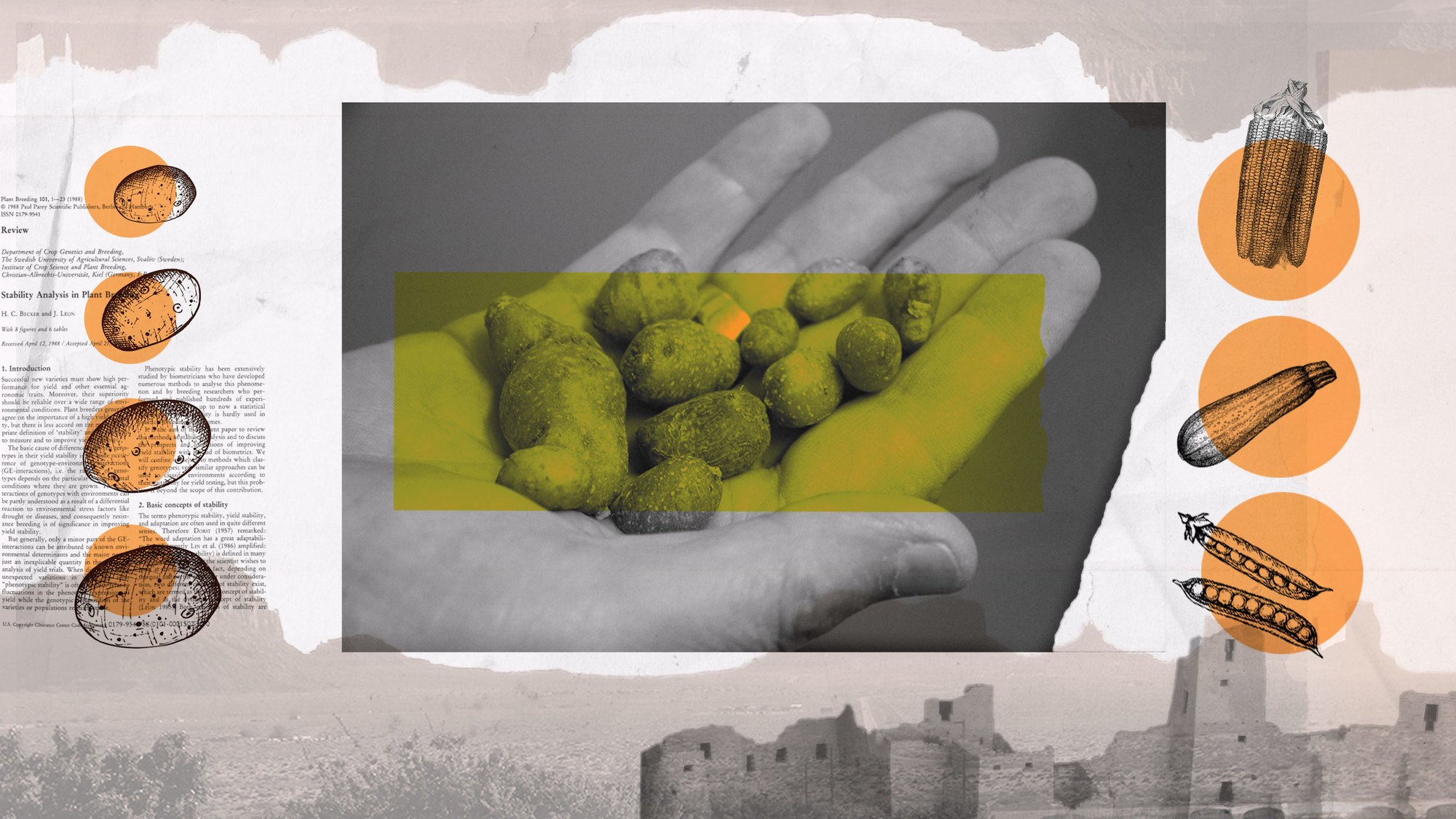
Graphic by Alex Hinton/Photos by James Dinneen and Kelly Vandellen/iStock Illustrations
Solanum jamesii, aka the Four Corners potato, has sustained Indigenous people in the American Southwest for 11,000 years; USDA is now studying its 8-year shelf life, and its resistance to disease, heat, and drought. The future of this remarkable little potato remains unwritten.
“Hello everybody,” Bruce Pavlik said to no one. It took me a second to realize that Pavlik, an ecologist at the University of Utah’s Red Butte Garden, was addressing the plants. We were standing above a wide desert canyon just outside Bears Ears National Monument in southeastern Utah; near us was a stand of juniper trees. Further out, the canyon bottom was dotted with fragrant sagebrush and twisted piñon. And somewhere down there, likely near two humps of red sandstone where people once lived for a thousand years, were the potatoes.
Lisbeth Louderback, Pavlick’s collaborator and spouse, appeared beside him wearing a backpack GPS rig. An archaeologist at the University of Utah and the Natural History Museum of Utah, Louderback would use the rig to mark the locations of any potato plants we found, precise to the millimeter. Leaves collected from each plant would then be sent to a lab for DNA sequencing, the latest data in a sprawling research project on a wild potato species called the Four Corners potato. In 2017, Louderback and Pavlik found evidence that Indigenous peoples in the Southwest have used the potato for at least 11,000 years—far longer than any other documented potato use in North America.
That finding spurred the pair to delve further into how Ancestral Pueblo, Ute, and Diné people used the potato along with maize, squash, and beans—the so-called “Three Sisters” core to Indigenous agriculture in the Southwest. Archaeologists believe the Three Sisters were first domesticated in Central America, then brought to the dryland farms of the Colorado Plateau through the extensive trading networks that existed at the time. Louderback and Pavlik suspected the potato had also been carried around, cultivated, and perhaps even domesticated, all within the Four Corners area. If true, the potato would represent one of only a handful of independent crop domestication events anywhere, and the only known example in North America west of the Mississippi. “It puts us on the map,” Louderback told me.
“Reconnecting to the potato brings back our stories, our songs, our connection to the landscape. It brings back the cultural memory of how we used to nourish ourselves.”
But plumbing the potato’s secrets has required more than just archaeology. What started with Louderback and Pavlik has grown into a collaboration between some unlikely partners, with different, arguably incompatible views of how the potato should be used and valued. These include Department of Agriculture (USDA) geneticist John Bamberg, who is leading the work to interpret the potato’s DNA for fingerprints of domestication. Separate from the archaeology, Bamberg is working to use the Four Corners potato’s unique genes to breed a common potato more resistant to disease, heat, and drought—an increasingly urgent project in the face of our changing climate. Bamberg’s team is also exploring some of the potato’s other singular traits, like its ability to remain viable for eight years in the fridge, or its resistance to extremely cold temperatures.
Also on the team is Cynthia Wilson, a Diné nutritionist and traditional foods advocate working to restore the potato to Native communities and gardens, and to collect ancestral knowledge from Diné elders. “Reconnecting to the potato brings back our stories, our songs, our connection to the landscape,” Wilson told me. “It brings back the cultural memory of how we used to nourish ourselves.”
In August, I traveled to the Four Corners area to learn more about this curious group, and the potato that has brought them together. From Salt Lake City, I headed south with Louderback and Pavlik in search of potato clusters that might have persisted from ancestral gardens. In the Monument Valley in the Navajo Nation, I met with Wilson at her home, where growing the potato seemed an act of defiance against centuries of oppression. And in Cloudcroft, New Mexico, I met with Bamberg, whose potato breeding research may well be a feat of modern agricultural science with a genetic debt to centuries of Indigenous farming. I left sure this most ancient potato, whichever way one chooses to see it, is anything but stuck in the past.
—

Cynthia Wilson holds a handful of Four Corners potatoes harvested from plants grown by a potato cultivation partner in Tséyi, Arizona.
Cynthia Wilson
Unless you are a uniquely experienced potato eater, the Four Corners potato, known by botanists as Solanum jamesii (pronounced james-EE-aye), is unlike any potato you’ve eaten. The potato you’ll find in a grocery store is Solanum tuberosum, the common potato. Idaho, Russet, Yukon and the rest are all varieties of that species, which was domesticated in the Andes around 8,000 years ago, cultivated by the Inca, and brought to the rest of the world by the Spanish in the 16th century. The Four Corners potato, Solanum jamesii, is related to the common potato in somewhat the same way coyotes are related to dogs. Its tubers are about as small and varied as grapes.
Louderback and Pavlik’s saga with the tiny potato began in 2013. Louderback was working to reconstruct ancient Southwestern diets using microscopic starch grains recovered from an archaeological site in Utah’s Escalante Valley. She had found grains she thought might be from the potato on an 11,000-year-old grinding stone, but had not yet developed a way to distinguish the grains of one potato species from another. And while there was ethnographic evidence that the potato had been used for centuries by Hopi, Diné, Zuni, and a number of other Indigenous groups, there was no evidence for potato use that far back in time. In any case, the plant was uncommon that far north. Even if the grains turned out to be from the Four Corners potato, it seemed unlikely to have been a significant source of food in the region. Louderback might have disregarded the unidentified grains, had two things not happened.
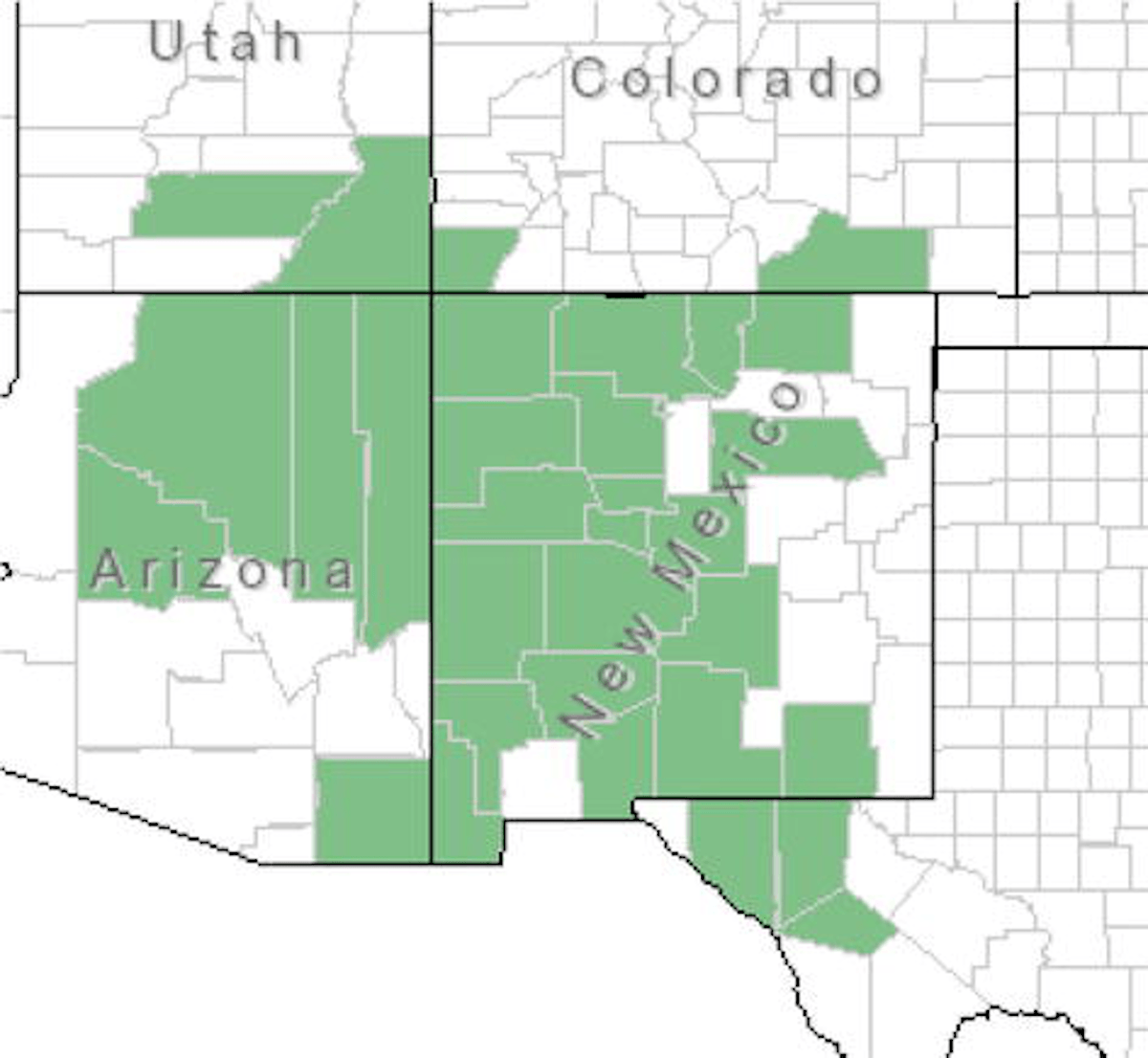
The Four Corners potato, Solanum jamesii, is found in the Southwest desert region.
First, doing field work one day, Pavlik found a small cluster of potato plants growing just a few hundred steps from the Escalante Valley site. Then, a few days later, the pair happened upon a book at a local bed and breakfast that claimed Mormon cavalry in the 19th century had called the Escalante area “Potato Valley.” The two finds suggested to them that the Four Corners potato may have been a more important food source than they had believed. Further, if people had not only foraged, but transported and cultivated the potato, it was also conceivable that selection by farmers of the best-performing plants and adaptation to new habitats had altered the wild potatoes into something more desirable to people, something domesticated. “We thought, this is too good,” said Pavlik.
It was conceivable that selection by farmers of the best-performing plants and adaptation to new habitats had altered the wild potatoes into something more desirable to people, something domesticated.
That’s not to say proving any of it would be easy. “[Archaeologists] aren’t used to thinking about living things,” Pavlik told me. “They’re all bones and stones. Living things aren’t so convenient.”
Over the next several years, Pavlick, Louderback, and a growing group of collaborators, including Bamberg and Wilson, pursued these suspicions about the potato along multiple lines of evidence: starch grains, geographic distribution, nutritional analysis, and traditional knowledge. With this, they established that the potato was used, transported, and cultivated widely in the Four Corners region. To show domestication however, they needed more DNA from potatoes growing near archaeological sites, which is why Pavlik and Louderback had appeared in the desert talking to plants.
—
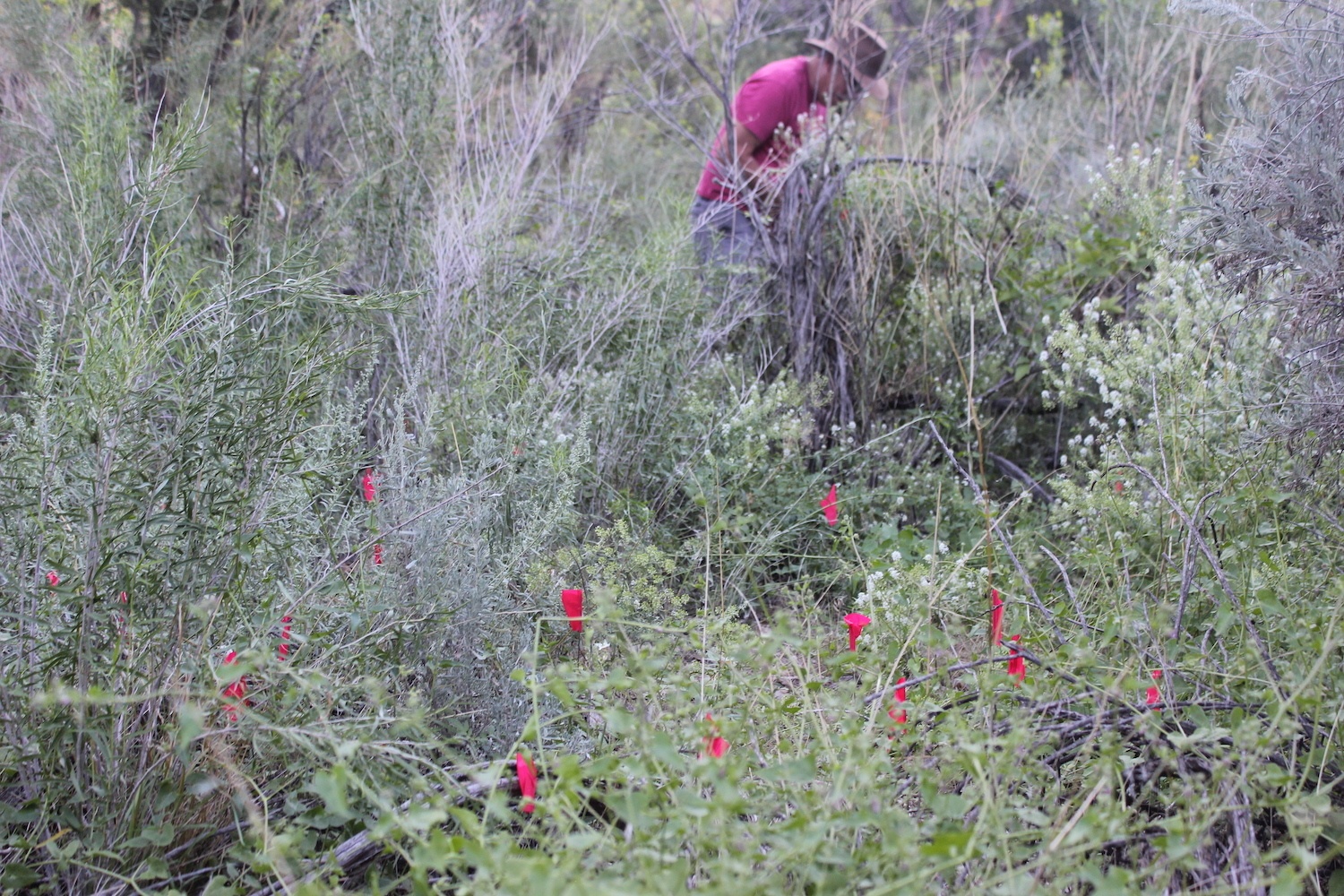
Bruce Pavlik marks Four Corners potato plants with red flags near Newspaper Rock State Historical Monument in southeastern Utah.
James Dinneen
Soon we were hiking down a steep sandy wash, still mushy from rain. This boded well. Without sufficient moisture, the potato’s tubers can remain underground for more than a decade awaiting their moment to sprout. That’s a sensible strategy for a desert plant, but it can make for tough collecting. In 2019, a dry year, the team’s first survey for the domestication project had been a disappointment. Then 2020 was a bust due to both drought and Covid-19. But this summer was looking up: On the drive from Salt Lake City south to Bears Ears, a late summer monsoon had brought every plant in that red desert country into its most vivid green.
Pavlik, up ahead, was the first to find potatoes. “Look at all of ‘em. Oh my god!” he shouted. When we caught up, he pointed out a cluster of at least 80 short leafy plants, topped with sweet-smelling white and yellow flowers. They were growing along the rim of a stone-ringed depression Louderback explained was likely once the foundation of a pit house. “Even on this small scale, the plants are with the archaeology,” Pavlik said. The ground around the potatoes was littered with fragments of ceramics, some with black and white geometric patterns, others with grooves finger-pressed in the clay.
After marking each potato plant with a bright red flag, the pair went to work collecting GPS data and leaf clippings, sealing each sample in teabag-like sacks to dry. Later, the leaves’ DNA would be purified, then sequenced. Differences between wild and archaeology-associated populations might then indicate domestication, especially if those genetic differences were linked to desirable traits like tuber size or bitterness. The hope was that these plants, and their genomes, were artifacts, just as much as the ceramics scattered around them.
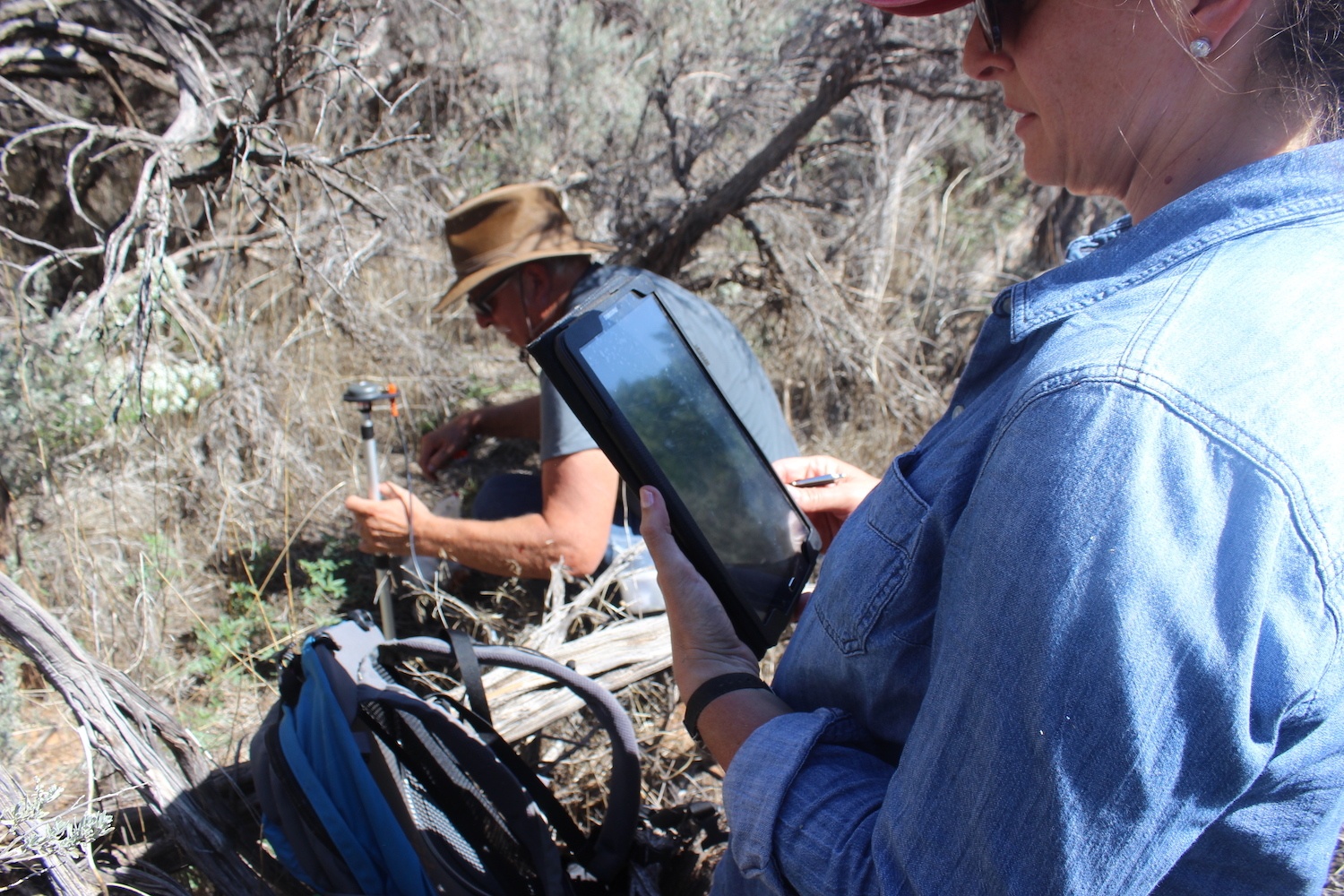
Lisbeth Louderback and Bruce Pavlick measure GPS coordinates of a Four Corners potato plant in an area near Bears Ears National Monument they call the “Potato Amphitheatre.”
James Dinneen
That evening, over a dinner of steak and mashed potatoes (what else?), Louderback and Pavlik explained what it would mean to find robust evidence that the potato had been domesticated. Though the genetic data remains preliminary (their most recent paper shows potatoes from archaeological sites often cannot produce seeds, a sign of a genetic bottleneck possibly caused by human transport) they agreed such a finding would put the Four Corners potato on the world-historical map of agricultural beginnings. It would point, as Pavlik put it, to “the genius of [Indigenous] stewardship and ancestry.” It would also deepen the story archaeologists tell about ancient diets in the Southwest, adding another energy-rich and nutrient-dense option to the middle-Holocene menu.
Proving Solanum jamesii was domesticated could also have implications for how the potato and other culturally significant plants are managed within Bear Ears and Grand Staircase-Escalante National Monuments, both of which were expanded by President Joe Biden in October on the recommendation of Interior Secretary Deb Haaland. (When Haaland, herself a member of the Laguna Pueblo, visited Bears Ears in April, she was served the Four Corners potato, twice.) Plants like the potato, Pavlik and Louderback argued, deserve to be better documented and protected, especially in ways that incorporate the people and knowledge responsible for protecting them in the first place. “It’s yet another example of ingenuity thousands of years before the white man came around,” Louderback said.
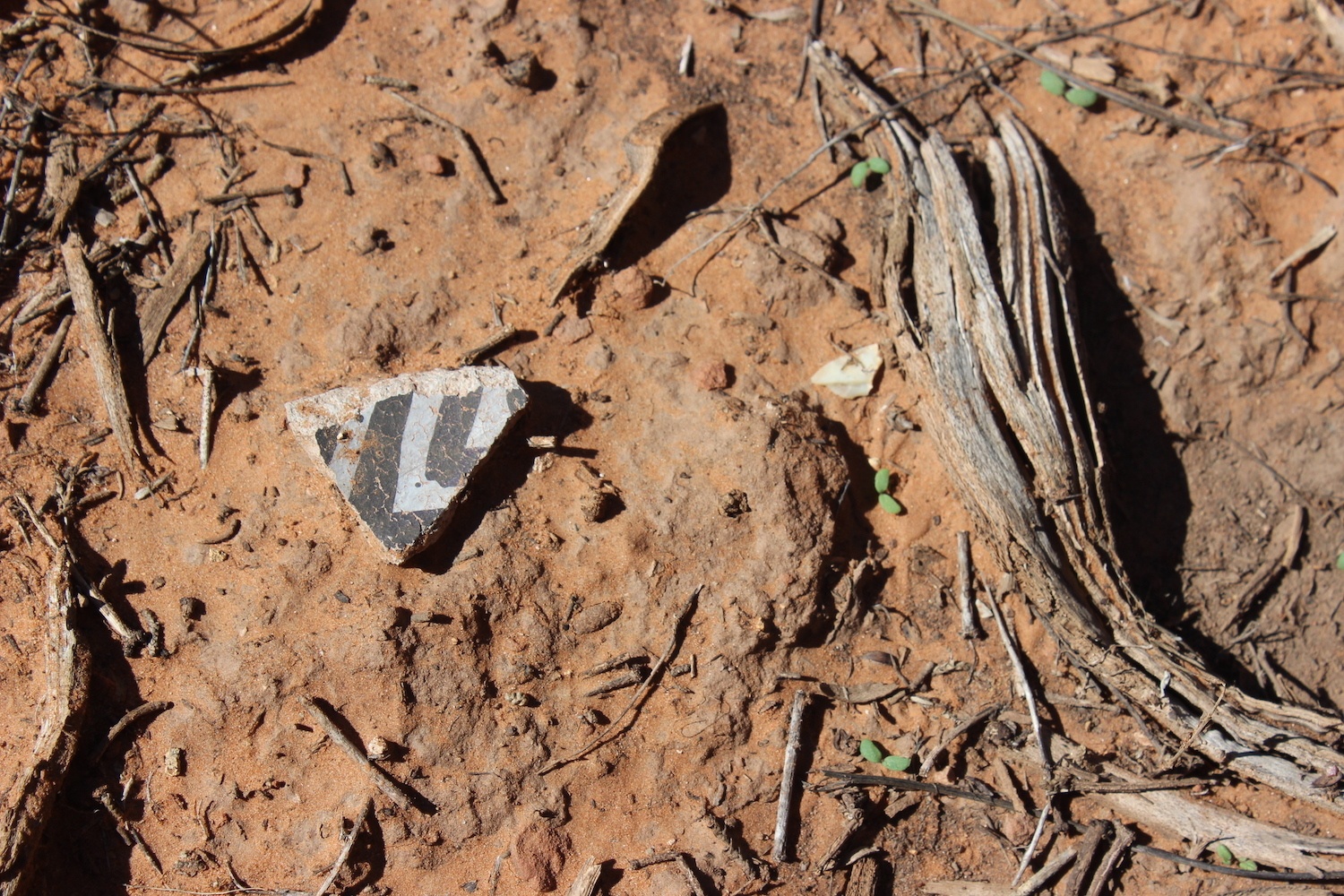
Potsherds are scattered at thousands of archaeological sites in and around Bears Ears National Monument in southeastern Utah.
James Dinneen
Of course, it’s not as though Indigenous people familiar with the potato require archaeological or genetic evidence to be sure of any of this. At meetings to discuss the potato with Native farmers, Pavlik said he often gets a similar response after going over his and Louderback’s research: “Well, we could have told you that.”
—
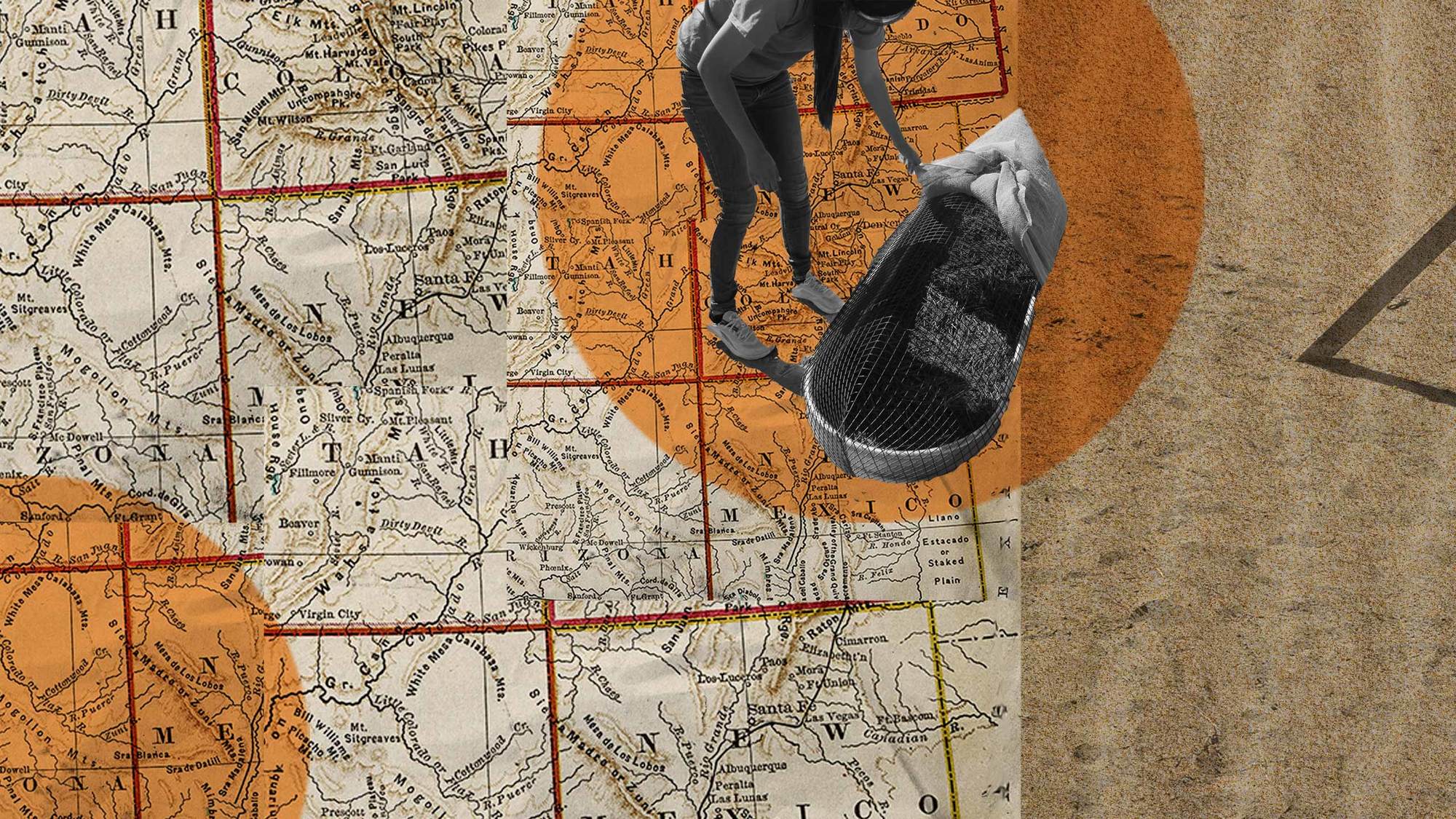
Graphic by Alex Hinton/Photos by James Dinneen/iStock map from The Palmer
The next morning, I met Cynthia Wilson, the Diné nutritionist working with the archaeologists, at the Navajo Nation Visitor’s Center in Monument Valley. She was leading a workshop on growing the potato for a small group of mostly older women, put on by a Navajo organization that promotes gardening as a way to tackle the high rates of Type 2 diabetes on the reservation. Wilson wore a sky-blue shirt with an image of a bear in silhouette, the logo for the Bears Ears conservation organization Utah Diné Bikéyah, where she previously directed a traditional foods program and is now a consultant (Diné Bikéyah means “sacred lands” in Navajo). Behind her rose the famous red mesas and hoodoos of the valley.
With the help of a large poster, Wilson told the story of the Four Corners potato project, from Louderback and the starch grains up to her own involvement interviewing elders, and helping more people to grow the potato despite the high winds, marginal soil, drought, and rodents gardeners often encountered on the reservation. “It’s important to know your own cultural foods,” Wilson said. Foods like sweet corn and the modern potato “are foreign to our diet. They came from elsewhere.” At the end of the presentation, she passed out tubers to anyone in the group interested in trying to grow them at home.
According to Wilson, at least 30 Native farmers and gardeners she knows of have started growing the potato through the program, including, most recently, the students of the Monument Valley High School. (When I visited the school, agriculture science teacher Theresa James showed me and her first-year biology class rows of healthy potato plants growing in raised wooden beds. The students had voted that any tubers the plants yielded would be returned to ancestral sites in Bears Ears and cultivated there.) Other Native farmers—including Hopi, Zuni, Paiute, and Ute farmers as well as Diné—have long grown the potato. According to Louderback, a few Mormon farmers also grow the potato, which Mormon pioneers ate when they first arrived in Escalante in the 1860s, and again to avoid starving during the Great Depression.
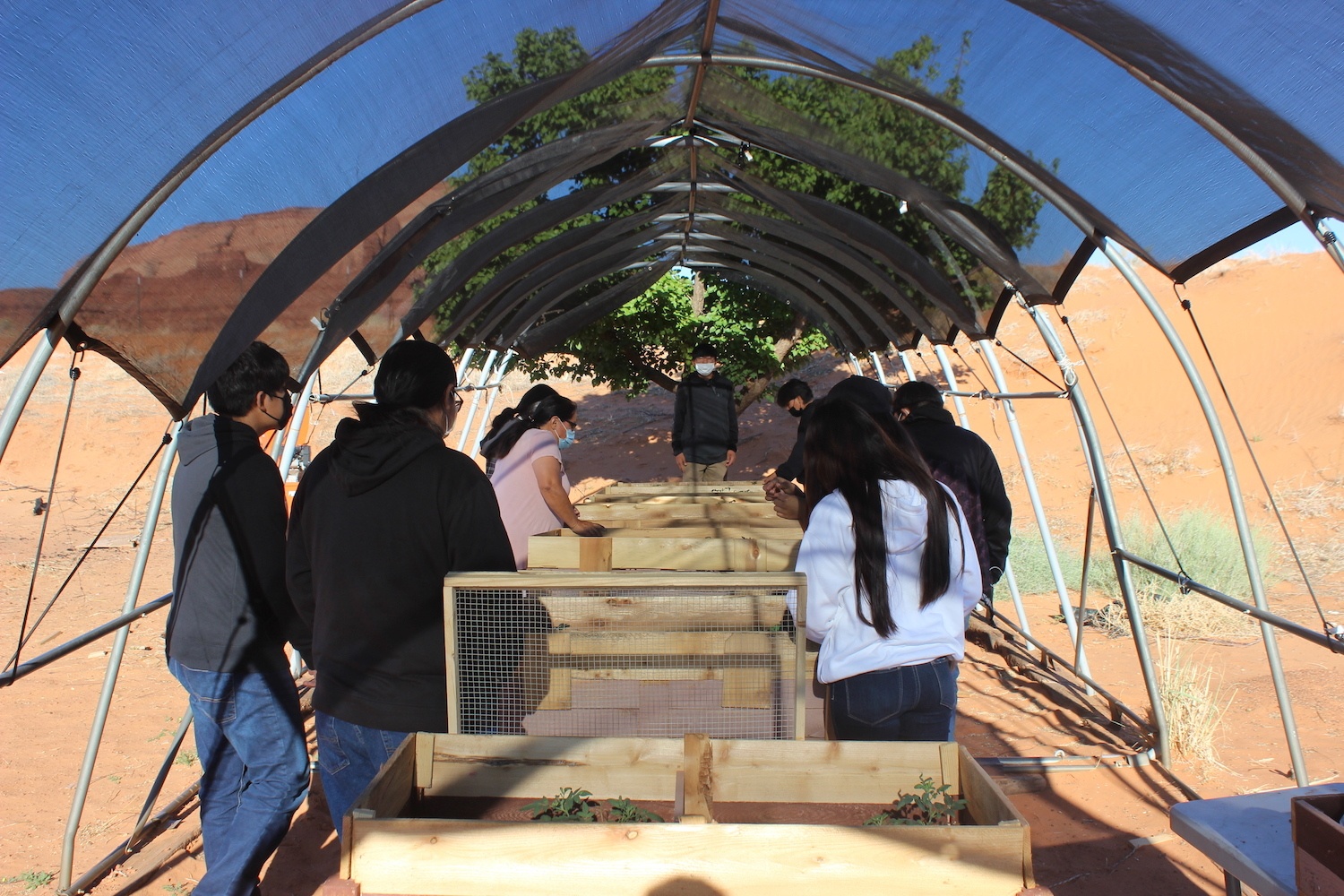
Theresa James introduces her first-year biology class to the Four Corners potato at the Monument Valley High School in Oljato-Monument Valley on Navajo Nation. The students voted to grow any tubers produced by the plants in Bears Ears National Monument.
James Dinneen
Wilson herself, however, had never heard of the Four Corners potato until Louderback approached her at a 2016 Bears Ears rally, where Wilson, then 27, spoke about her connection to the land as a Diné woman. At first, Wilson had been a little wary of working with non-Native scientists on a culturally significant plant, but she asked a few elders about the potato and they knew all about it, including her mother, Elouise, who remembered her own father talking about the tiny potatoes. Wilson’s mother had also said she thought Navajo families may have carried and dispersed the potatoes on the Long Walk—the 1864 forced march of thousands of Navajo people from their homeland by the U.S. Army. Scattering potatoes would have been a way to mark the path, and ensure a source of food on the way back. “People validated it was part of who we are,” Wilson told me.
She has since interviewed numerous elders about how the potato is best grown and prepared, learning, for instance, that boiling the potato with a white clay called gleesh’ makes the tubers less bitter, and that the potatoes grow well when their soil is mixed with pine needles. A number of people she spoke with knew about the potato, but had never tried it themselves. “It seems like it skips a generation,” Wilson said. “Elders talk about their grandparents using the potato.” She attributed this gap to assimilation during the century-long boarding school era, as well as prior displacement and cultural genocide. “A lot of food systems were destroyed. We were put on reservations and lost access to farms,” she said.
Now, Wilson was growing potatoes herself in what could only be described as extremely tough conditions. In the family plot, several miles down a red sandy road from the visitor’s center, Wilson’s potatoes grew in metal bins shaded with burlap. There were also a few rows of corn sagging in the heat. To keep the plants—and their several horses and Navajo sheep—watered, Wilson’s father must haul a 350-gallon tank to town and back every day in his truck, along with the water tank which supplies the house. According to Wilson and outside estimates, more than 30 percent of homes in the Navajo Nation lack running water.
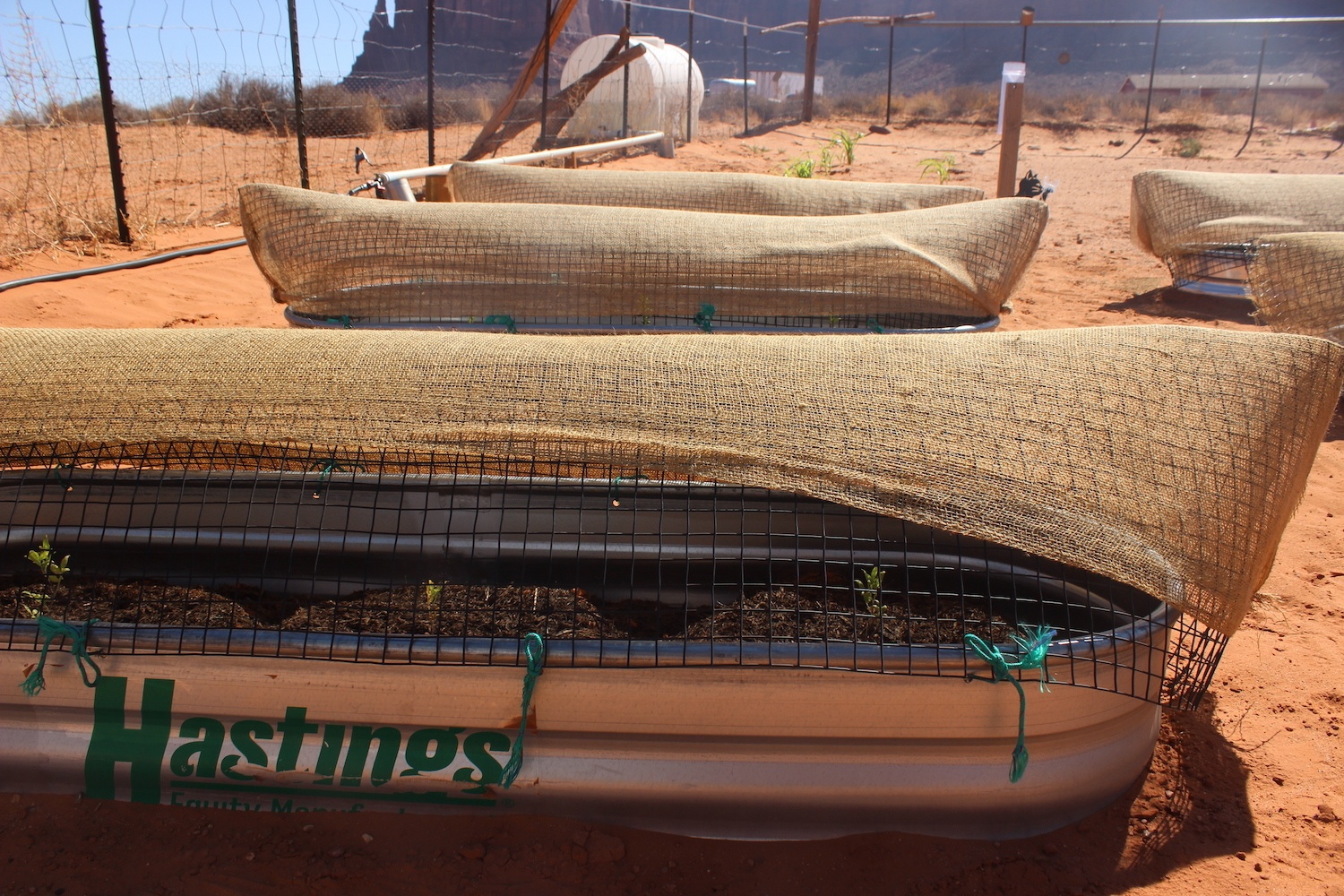
Cynthia Wilson and her family grow Four Corners potatoes in metal tubs shaded with burlap in the Oljato-Monument Valley on Navajo Nation.
James Dinneen
I asked about challenges growing the potato in such a dry place. “A lot of people here have been blaming drought, but I think it’s also about policy,” said Wilson, and soon we weren’t talking about the potato at all. She pointed out that while many people in the Navajo Nation lacked electricity and running water, people in Blanding just 50 miles north of where we spoke had sprinklers watering grass lawns. Covid-19, which has killed a disproportionately high number of people in the Navajo Nation, had made that disparity even more acute. “We lost a lot of our elders who are our knowledge holders,” she said. “A lot of them could have been saved if we had our infrastructures in place.” Wilson said Covid’s toll had included one of her neighbors, who was among the first people to join the potato program, and had given many tubers he grew to friends in the Monument Valley.
“Even though we are the original people of this place, we are the least served in this country,” Wilson said. “All those injustices are a part of why we do what we do, reclaiming true narratives of our people. And the potato is just a small model example of beginning to reclaim that cultural identity … Western people say we live in a food desert. But we were taught to know our plant relatives …. My hope is that we open our eyes that we have food around us. We have medicine around us.”
As far as the archaeological research that had brought Wilson to the potato, it was only further validation for what was already known in the oral histories. “Science is barely catching up to Indigenous ways of knowing,” Wilson said. Indigenous people have always known what can be learned from plants and animals, she said. “They hold all the stories of the living.” They may also hold the stories of the dead.
—
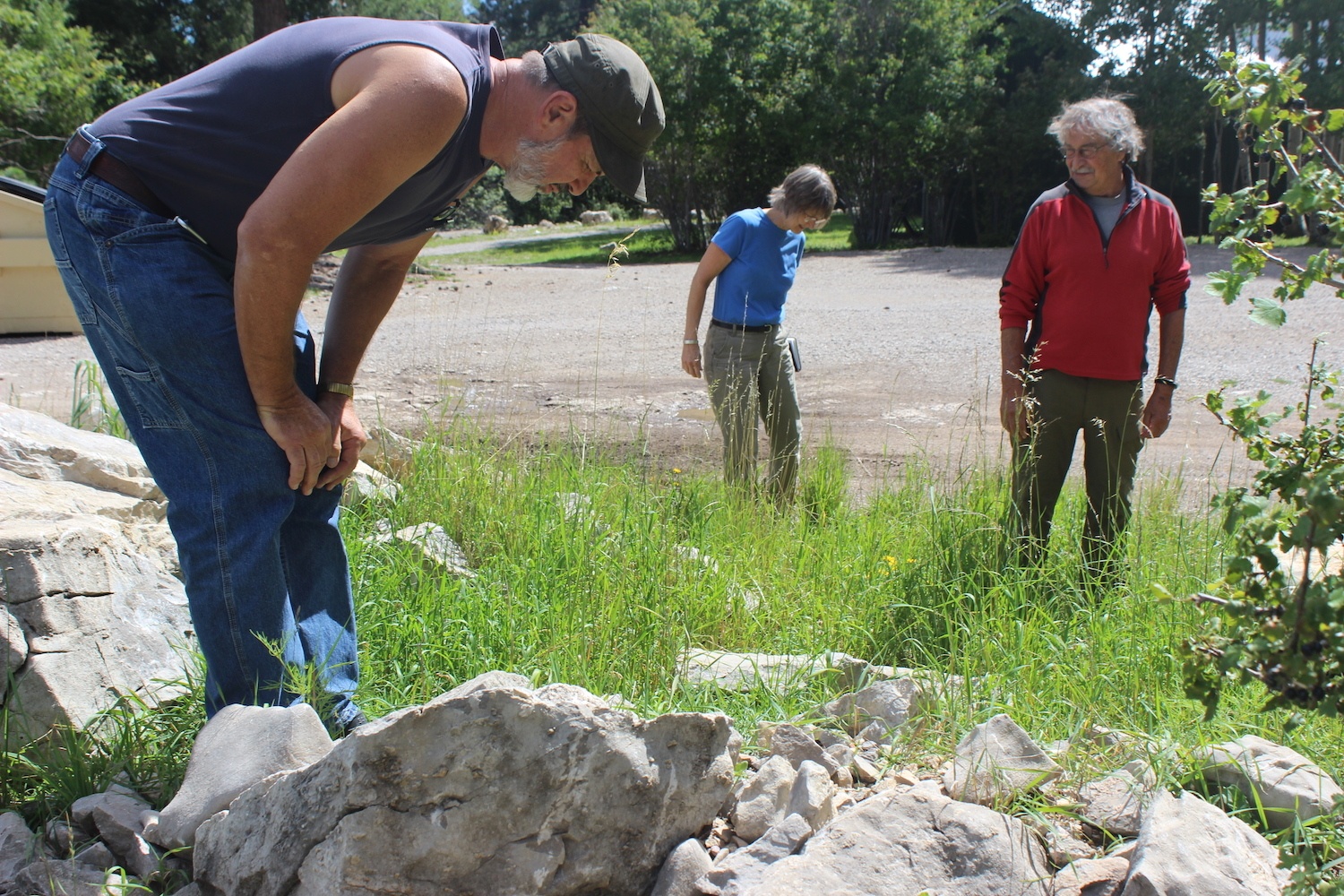
John Bamberg, Ingrid Bamberg, and Charles Fernandez (from left to right) search for Four Corners potatoes in Cloudcroft, New Mexico.
James Dinneen
My last stop was the mountain town of Cloudcroft, New Mexico, where USDA geneticist John Bamberg, his wife Ingrid, and their longtime potato-collecting partner Charles “Chico” Fernandez, had reunited to collect Four Corners potatoes across its southern range. Some samples would be for the archaeology project; others would go to the U.S. Potato Genebank in Sturgeon Bay, Wisconsin, where exotic potato varieties are maintained for breeding research. Bamberg, who directs the genebank, had last been in Cloudcroft in 1992, searching for potatoes as part of an international effort to collect and preserve potato genetic diversity. A renowned potato expert from Peru who had come on the trip was skeptical any wild potato could grow so high and dry. Yet they had found potatoes, both Solanum jamesii and another wild species called Solanum fendleri.
Thirty years later, potatoes were still there. Bamberg, who was sporting Crocs, a cutoff tee, and a green cadet cap, pointed to them growing like weeds next to the parking lot of a Family Dollar. “Here’s one,” he said, peering down at a plant. “They’re very much associated with people. And not. They like disturbed spots.”
If anyone would know, it’s him. In the three decades since that first trip to Cloudcroft, Bamberg has trekked across the Southwest in search of potatoes. He, and often Ingrid, went everywhere—Bears Ears, Chaco Canyon, Mesa Verde, Betatakin, across the Mogollon Rim and into west Texas—following every lead from older herbarium surveys, historical accounts, locals, and Indigenous people. The hundreds of potatoes collected, catalogued, and mapped by Bamberg were to a large extent the basis for Louderback and Pavlik’s first intuitions about the outlying potato populations in Escalante.
Jamesii’s arsenal of traits, its drought and heat resistance, could help farmers adapt to climate change.
None of that collecting, however, was for archaeological purposes. Bamberg’s main aim was to preserve a maximum amount of Solanum jamesii’s genetic diversity in order to harness it for agriculture. This was also the purpose of the more than one hundred other potato species and one thousand varieties maintained at the genebank. The difference with jamesii, was that it was, as Bamberg put it, “our native son.” It’s the only wild potato species that has nearly its entire population contained within the United States. That had both symbolic and practical significance. It meant travel and language were less of a barrier, and it also meant Bamberg could collect and use what he collected without having to deal with the international treaties that regulate genetic resources. The few times he collected on tribal lands, Bamberg told me he always got permission from individual landowners, though he said he never sought permission from tribal governments. “Permissions from tribes was overwhelmingly a moot issue, since we very rarely explored on tribal land,” he wrote in an email.
In addition to that unfettered access, the Four Corners potato was stacked with useful traits. Over years of research, Bamberg’s group discovered it to be extremely resistant to potato scourges like late blight—the fungus responsible for the Irish Potato Famine—as well as the Colorado potato beetle, all without the use of fungicide or insecticide. They found it was packed with antioxidants, and possibly more nutritious than common potato varieties. In addition, the potatoes were able to remain viable for as long as eight years in the fridge. And even as their desert habitat suggested they tolerated drought and heat, the tubers were impressively resistant to cold: jamesii growing in the Bamberg’s garden survived the Wisconsin winters at 20º below. “It does stuff no other species does,” Bamberg said.
But getting those valuable genes into a variety farmers would actually want to cultivate is easier said than done; jamesii is just too different to be crossed with the common potato directly. Bamberg’s group tried unsuccessfully for years. In April, however, the group reported a big step forward in the American Journal of Potato Research: they had successfully crossed jamesii with a genetically intermediate “bridge species.” They have since made crosses between those jamesii-“bridge” hybrids and a cultivated variety of the common potato. In August, the seeds from that cross had sprouted in Wisconsin. Bamberg now has a few plants, though he has yet to confirm with genetic tests they are in fact jamesii hybrids.
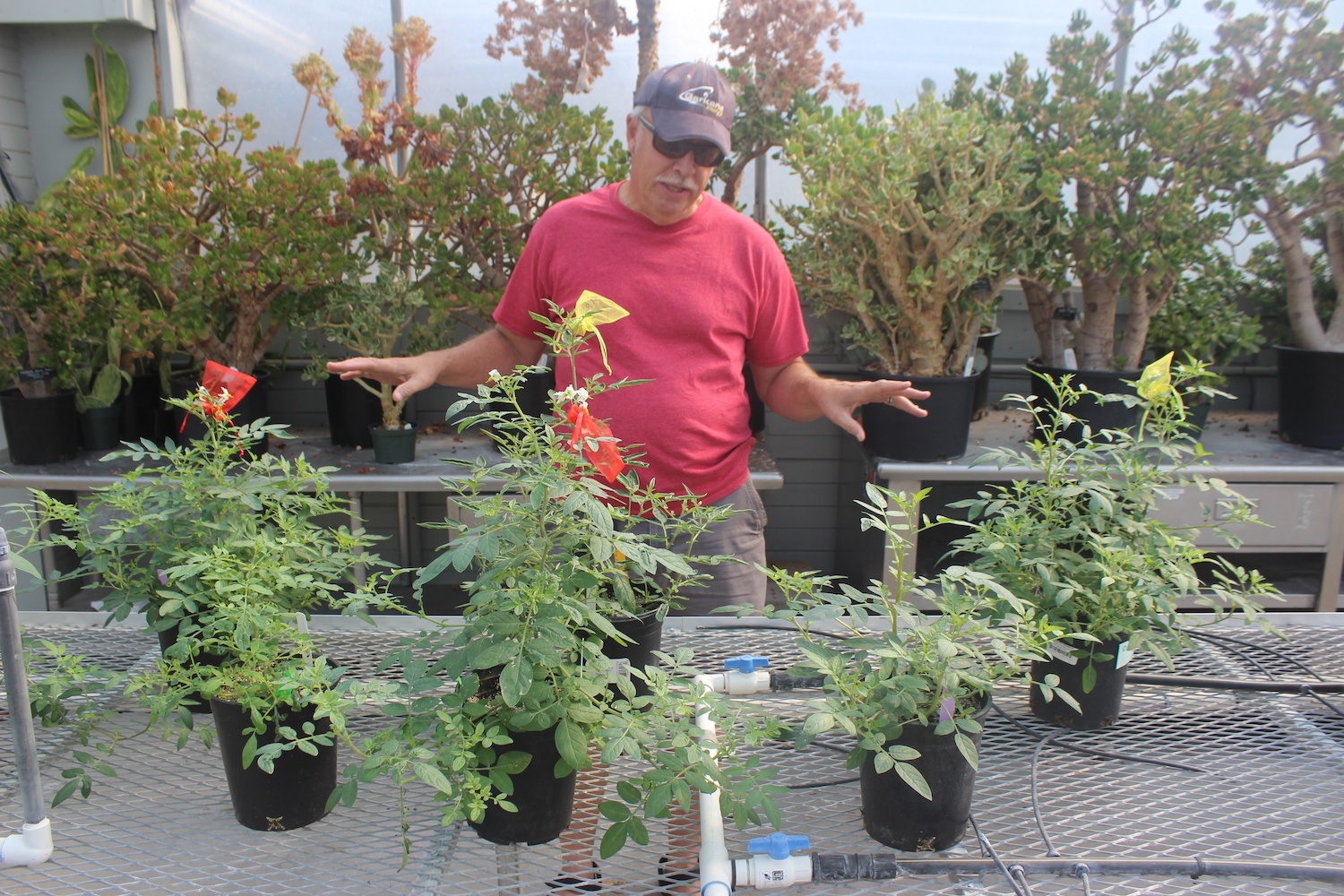
Bruce Pavlik conducts crossing experiments with Four Corners potatoes at the University of Utah’s Red Butte Garden in Salt Lake City. The researchers recently found that potatoes from populations associated with archaeological sites were unable to produce seeds, suggesting a genetic bottleneck that might be due to transport by people.
James Dinneen
There are lots of ways the breeding project could fail, especially if it turns out “weedy” jamesii traits like small tuber size or bitterness can’t be separated from the desirable ones like disease resistance, but for the first time in the history of potatoes, there exists a strain of the formidable Solanum tuberosum—one of the world’s most important crops—with jamesii genes on board. Bamberg plans to make that breeding material available for free to any breeders or farmers who wish to use it. “That would be a good conclusion to my career,” Bamberg said. “Not just to have collected jamesii, but to have made it available to potato improvement.”
Though far off at this point (potato breeding is notoriously slow), such a variety could conceivably save farmers millions of dollars in crop losses and chemical costs. Jamesii’s arsenal of traits, its drought and heat resistance, could help farmers adapt to climate change. It could end up as a more appealing and nutritious potato. It could also turn out to be worthless, for reasons of taste or shape or habit or anything else, incompatible with the discerning requirements of growers and consumers. “You don’t really know how valuable germplasm is going to be,” Bamberg said.
But let’s say a potato variety descended from the jamesii hybrids turns out to be a blockbuster, the hottest thing to hit Idaho since the Russet Burbank. After my time with Wilson, and the archaeologists, I had to wonder about the breeding work in the context of the Four Corners potato’s 11,000-year history. Louderback and Pavlik had joined with Bamberg to help determine if some of jamesii’s supremely useful genes might have benefited from the work of Indigenous farmers. If so, would these new and improved potatoes created by all the sophisticated tools of scientific breeding owe some kind of genetic debt to them? And how would people snacking on jamesii-hybrid potato chips years from now repay that debt, or even know who to thank?
—
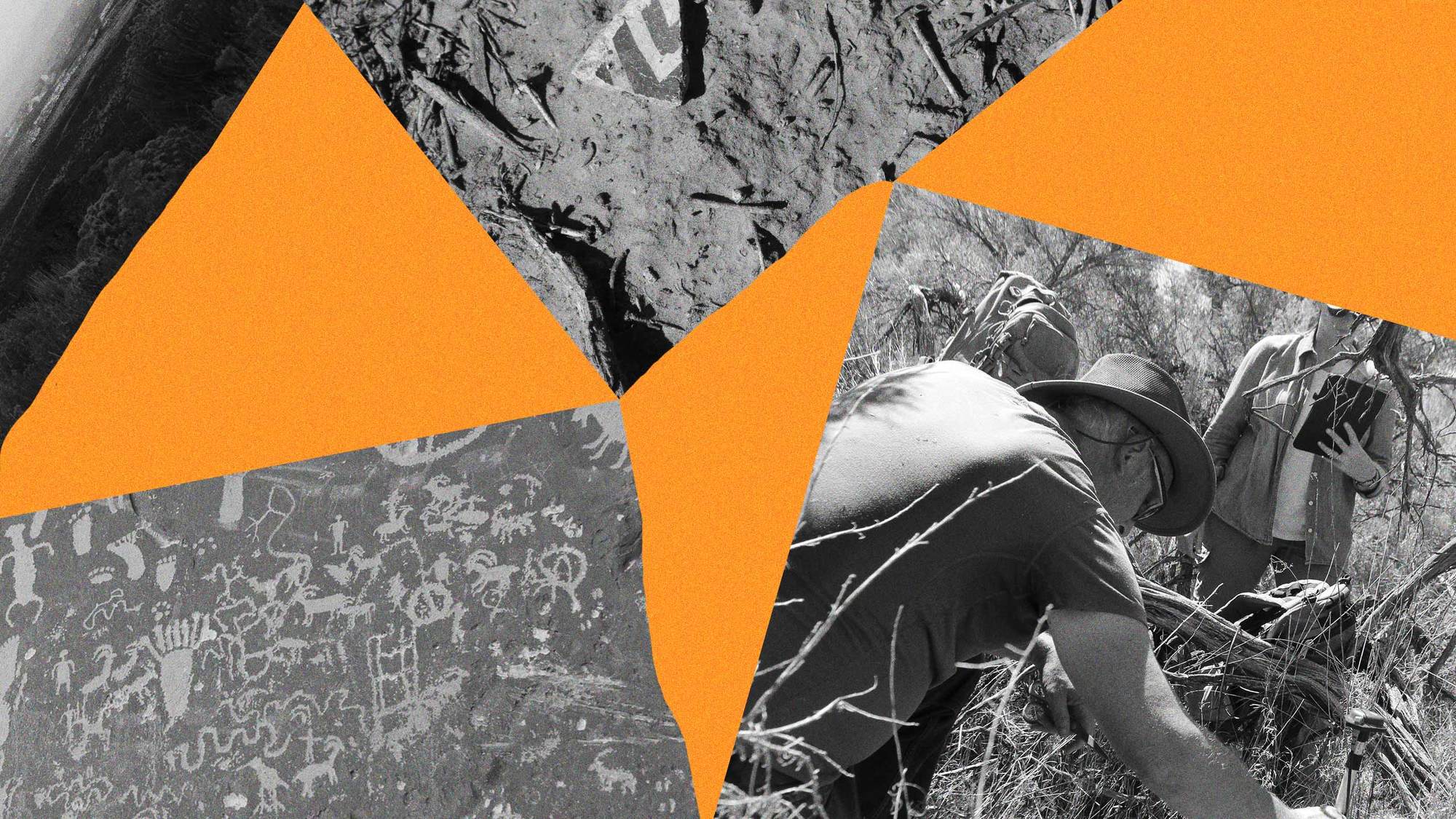
Graphic by Alex Hinton/Photos by James Dinneen
While the case for the Four Corners potato’s domestication remains uncertain, I spoke with a number of Indigenous people familiar with the potato who had concerns about the breeding research, especially given that much of the USDA’s work has happened without the formal participation or permission of any of the tribes connected to the potato. Several people were particularly wary about varieties with jamesii genes being patented by large commercial agricultural concerns, and that Indigenous contributions to stewarding the potato (and possibly domesticating it) would not be acknowledged.
Lyle Balenquah, an independent Hopi archaeologist, drew parallels with Hopi corn. “We grow many different varieties that have been selectively cultivated over thousands of years to be suited for this environment,” he said. “And so we view that as our intellectual cultural property. It’s something that we have invested many lifetimes in bringing about, and we view it as a big responsibility for us to be able to maintain that knowledge and not have it commercialized.”

Cynthia Wilson
Alastair Bitsoí holds a Four Corners potato plant at a potato cultivation training in Bluff, Utah.
Others had concerns not about possible commercialization of the potato or its hybrid descendants, but about how the breeding would affect the potato’s identity. “Caution. Caution,” said Marlene Valentine, a health educator with the Navajo Nation Special Diabetes Project, which organized the gardening workshop led by Wilson. “When we change the genetics of something that is good, we water down the significance of it.”
Karlos Baca, an Indigenous traditional food and medicine educator and activist, grows the potato at home and in the wild. He voiced his concerns more strongly. “The so-called work the USDA is doing in the genetic theft from our Indigenous potato is just a mirrored image of the kidnapping and erasure that the government attempted on us,” he wrote in an email. “The stealing of genetic information from our communities is well documented and this is no different.” He drew a parallel with a well-known case in which researchers collected DNA samples from the Havasupai Tribe of northern Arizona; the researchers told participants the samples would only be used for diabetes research, but used the samples to study schizophrenia, ethnic migration, and inbreeding.
When I discussed these concerns about the potato with Bamberg, he pointed out that the potato does not exclusively, or even primarily, grow on tribal lands. “It wouldn’t even particularly work to reclaim ownership rights because there are freely available sources,” he said. He also reiterated that accessions resulting from the breeding work were available to anyone, and that the jamesii plants directly involved in the breeding work were not collected from tribal lands. “I have tried to be very careful to make sure we weren’t trying to monopolize, or steal, or horde anything,” he said. “We want it to improve the U.S. potato crop, but [also to improve] the Peruvian potato crop, or the Navajo potato crop just as much…It’s all freely available to you in a better form.”
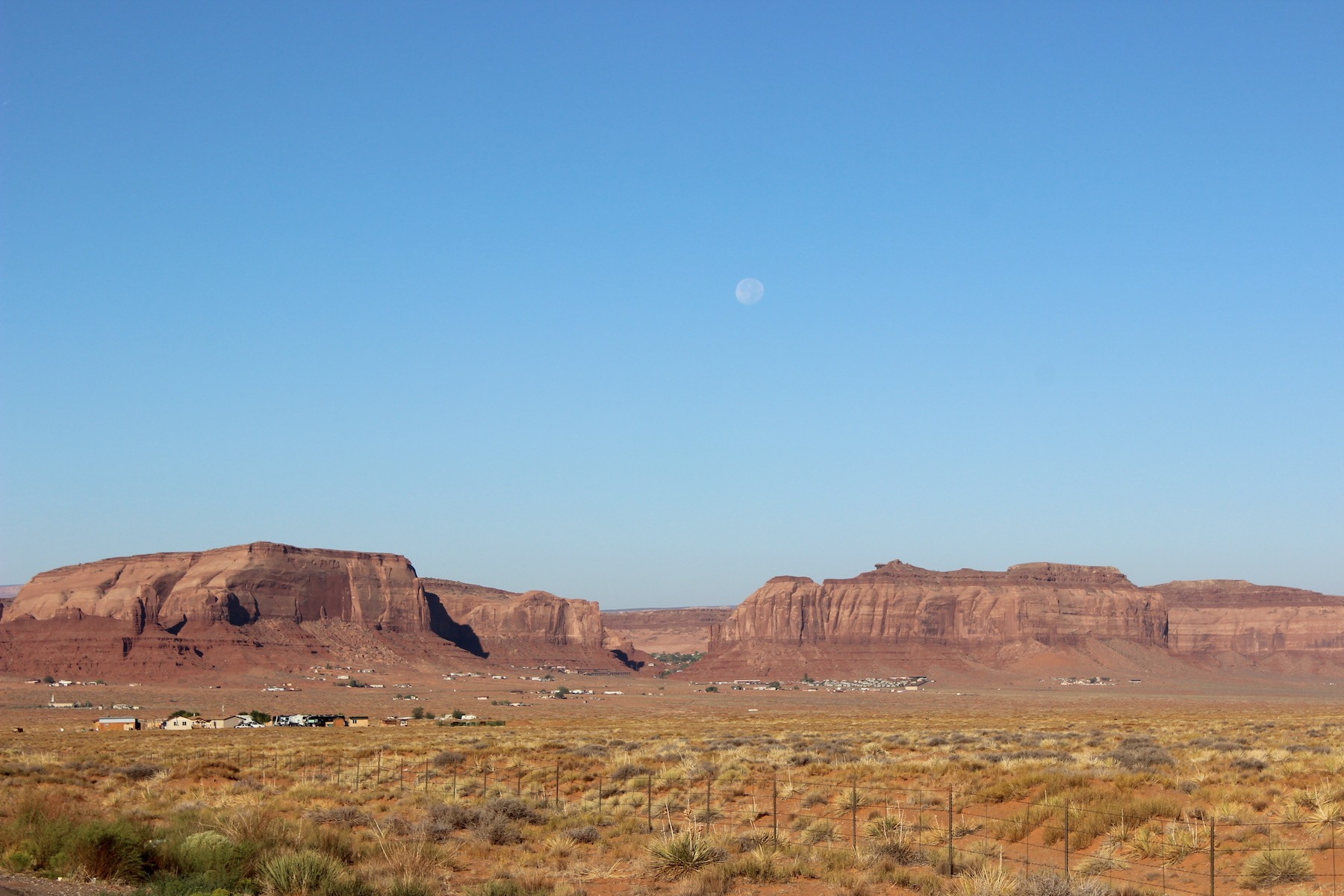
The moon rises over Oljato-Monument Valley on Navajo Nation. Cynthia Wilson estimates 10% of the homes in the Monument Valley lack running water.
James Dinneen
A USDA spokesperson commented that plant exploration for the National Plant Germplasm System on tribal lands is governed by the same code of conduct that applies to exploration in any sovereign nation. The code recognizes national sovereignty over plant genetic resources as described in key international treaties on biodiversity. “Accordingly, access to genetic resources is subject to prior informed consent (PIC) of the national authority in the host country” the spokesperson wrote in an email.
The spokesperson also said the USDA has no jurisdiction over germplasm once it sends the material to an outside breeder, and that of the 250 or so jamesii samples in the genebank, most did not originate from tribal lands. The spokesperson did not address a question about what obligations the USDA has in cases in which germplasm was collected from tribal lands without permissions or benefit-sharing agreements in place.
When I asked Wilson about the breeding research, she didn’t know much about it (she didn’t personally know Bamberg), and has tried to keep her distance. But she said the Diné elders and farmers she had interviewed probably would not support it. “How can we relate to it when it’s something that is foreign?” she said. Mainly, though, she wasn’t all that interested.
“We grow many different varieties that have been selectively cultivated over thousands of years to be suited for this environment. We view that as our intellectual cultural property. It’s something that we have invested many lifetimes in bringing about, and we view it as a big responsibility for us to be able to maintain that knowledge and not have it commercialized.”
For her, the tiny potato is the beginning of something greater than a valuable new crop. It’s the beginning of a “rematriation” of food and culture that was appropriated or destroyed. The potato will continue to be shared with Indigenous communities in the Four Corners, with both food and knowledge shared in the exchange. And if potato plants from the high school produce tubers (Ms. James was only cautiously optimistic), they will be brought back to Bears Ears, and planted among the ancestors.
Earlier, Wilson had told me the Diné name for the potato: nimási yazhi. “Nimási,” she explained, means potato. “Yazhi” is harder to translate, but in relation to a person, it means something like “little one,” a term of endearment. It’s the word her mother sometimes uses to refer to Wilson, or what Wilson calls her young nephew. “In our prayers, even in our songs, they say to Mother Earth, ‘I am your child. I am your little one.’”
